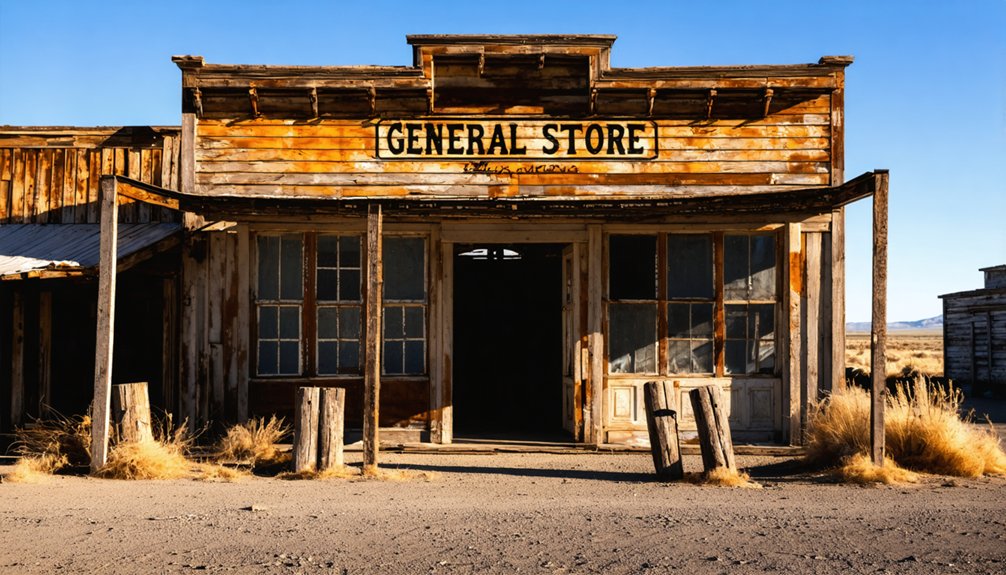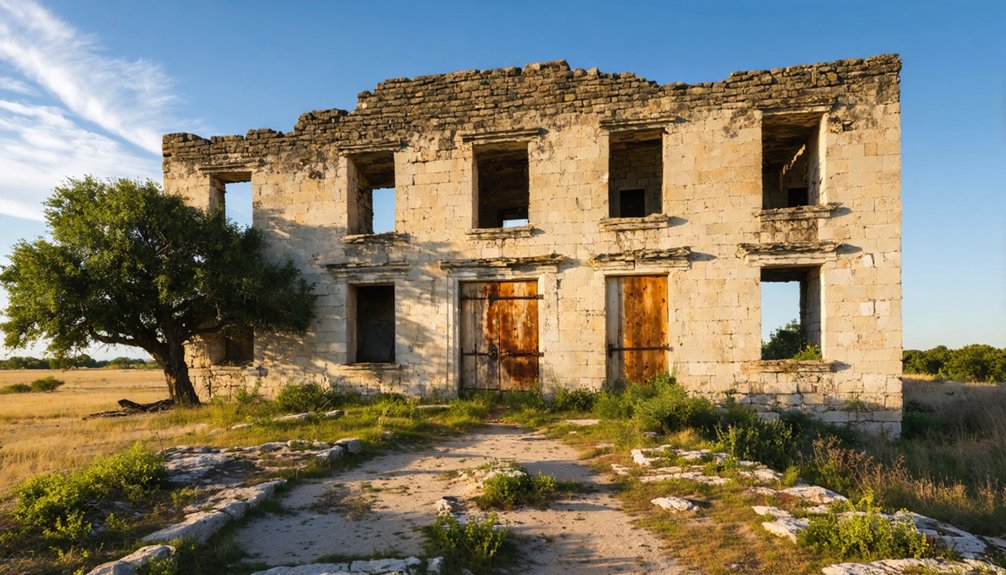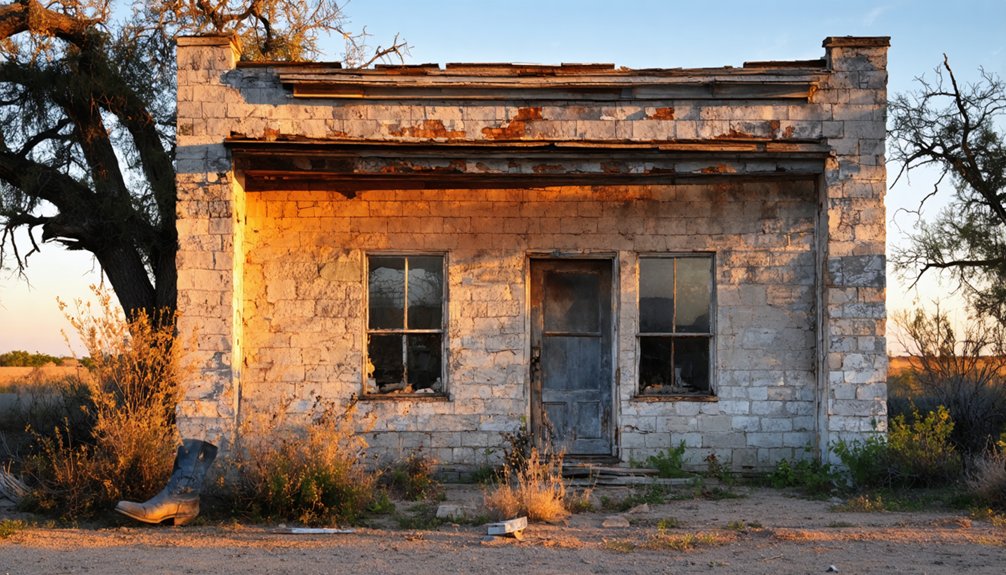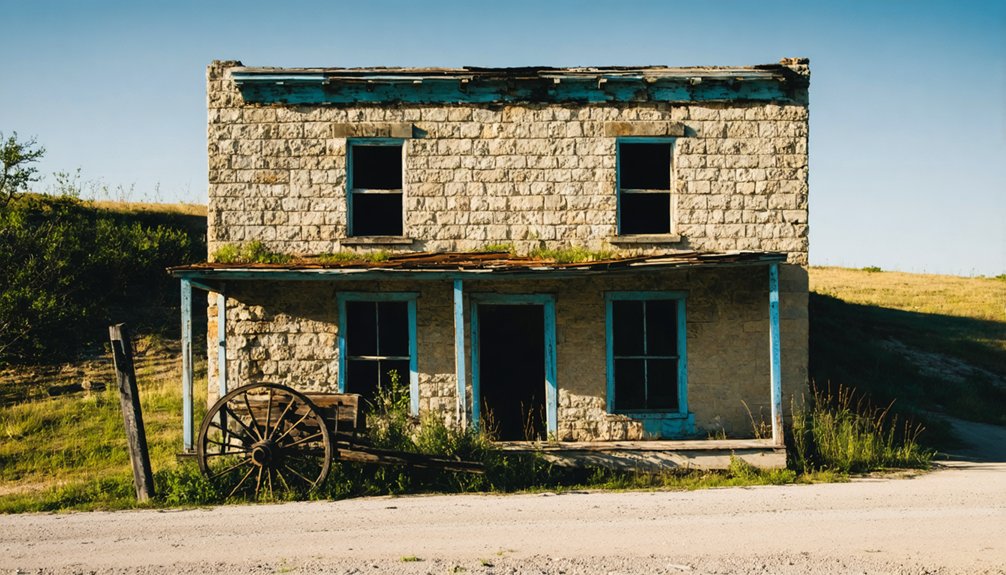You’ll find Camp Verde, Texas, 12 miles south of Kerrville, where the U.S. Army established a frontier outpost in 1855. This historic site gained fame as headquarters for the military’s Camel Corps experiment, testing 75 camels for desert transport. After the Army abandoned it in 1869, Camp Verde transformed into a ghost town, though you can still visit the 1900s stone general store and remnants of the original fort. The fascinating tales of frontier innovation and military history await in this Hill Country locale.
Key Takeaways
- Camp Verde transformed from a thriving U.S. Army post to a ghost town after its official abandonment in 1869.
- A devastating fire in 1910 significantly damaged the settlement, accelerating its decline from a military outpost.
- The historic Camp Verde General Store, built around 1900, remains standing as one of the few surviving structures.
- The site retains architectural remnants of the Camel Corps experiment, including original camel pens and officers’ quarters.
- The former military post now consists mainly of scattered ruins, the general store, and the Blue Silver Dollar Saloon.
The Birth of a Military Outpost
When the U.S. Army established Camp Verde on July 8, 1855, they’d chosen a strategic location that would reshape frontier defense in Texas.
You’ll find the outpost’s original position on Verde Creek’s northern bank near Bandera Pass, where it served as a significant defensive position against Native American raids.
Soldier life at Camp Verde centered around protecting settlers and maintaining control of essential routes through the Texas Hill Country.
The post quickly grew to include important facilities like barracks, fortifications, and supply depots.
The military began conducting groundbreaking research into using camels for transportation.
By 1857, Williams community store had opened adjacent to the camp, offering soldiers goods they couldn’t get inside – especially liquor.
Charles Schreiner took ownership of the store in 1858 and began supplying wood and beef to the military post.
A year later, the addition of a post office transformed Camp Verde into a hybrid military-civilian hub, reflecting its growing significance in frontier Texas.
The Legendary Camel Corps Experiment
You’ll find the Army’s innovative Camel Corps experiment at Camp Verde began in 1856 when Jefferson Davis, as Secretary of War, orchestrated the importation of 75 camels from North Africa and the Middle East.
The exotic beasts arrived at Texas ports before handlers moved them inland to their new home base at Camp Verde, where the military would test their capabilities against traditional pack animals. The camels demonstrated remarkable endurance by carrying 700 to 900 pounds while traveling long distances without water.
These Mediterranean camels proved remarkably successful in early trials, with just six camels carrying double the load of two six-mule wagons while completing routes considerably faster. Under the command of Lt. Edward Fitzgerald Beale, the camels helped construct a vital government wagon road that would later influence Route 66.
Military’s Bold Innovation
Among the most ambitious military experiments of the 1850s, the U.S. Army’s Camel Corps emerged from Secretary of War Jefferson Davis’s determined vision to revolutionize military logistics in the Southwest.
After securing $30,000 in Congressional funding, the Army dispatched Major Henry C. Wayne to acquire camels from the Mediterranean.
You’ll find that by 1857, the Corps had grown to 75 camels, demonstrating remarkable camel adaptability during critical missions. These hardy animals proved their worth in extreme conditions, completing a 114-mile trek without water and saving lives during a harrowing Mojave Desert survey. The dromedaries showcased their superior strength by carrying up to 1000 pounds of cargo, far exceeding the capacity of traditional pack mules. These impressive beasts displayed natural desert abilities, utilizing their padded feet to traverse fragile desert ecosystems with minimal damage.
The Corps even developed specialized artillery crews, showing the military’s commitment to innovation.
While the Civil War ultimately derailed this bold experiment, the Camel Corps represented a pioneering attempt to adapt military transport to America’s challenging frontier terrain.
Mediterranean Camels Meet Texas
Camp Verde, Texas became the heart of America’s ambitious Camel Corps experiment, situated 60 miles north of San Antonio in the rugged Hill Country.
You’ll find that 75 camels from Turkey and Egypt transformed this military outpost into a unique desert survival testing ground. These Mediterranean beasts proved their worth, outpacing traditional pack animals in both speed and strength.
The camel adaptation to Texas terrain was remarkable – six camels could carry loads equal to two six-mule wagons, arriving nearly two days faster. Jefferson Davis himself championed the initiative, securing $30,000 in funding to launch the pioneering program.
They thrived in the arid conditions where horses and mules struggled, demonstrating exceptional endurance across unexplored regions like Big Bend.
While soldiers initially battled dehydration, these desert-bred animals pressed on, proving their superior capability for military transport in the challenging Southwest environment. The experiment came to an end when the Civil War broke out, leading to Confederate forces taking control of the camp.
Experiment’s Surprising Early Success
When the first camel caravan arrived at Camp Verde in 1856, few could have predicted the remarkable success that would follow over the next decade.
You’d have witnessed these hardy desert creatures outperforming horses and mules in nearly every trial, showcasing unprecedented camel endurance across the harsh western terrain.
The military logistics advantages became clear as the camels hauled heavy supplies between Camp Verde and San Antonio with ease. Jefferson Davis advocated strongly for using these desert animals as pack animals in the American West.
They proved their worth spectacularly during Edward Beale’s 1857 expedition to establish the 35th Parallel Wagon Road, and again in 1861 when they helped a survey team survive being lost in the Mojave Desert.
The camels’ superior load-bearing capacity and ability to thrive in arid conditions offered a revolutionary solution to the Army’s transportation challenges in America’s expanding western territories.
Life at Camp Verde During the Civil War
As the Civil War erupted across America, life at Camp Verde underwent dramatic changes following its bloodless capture by Confederate forces on March 7, 1861.
Lieutenant Hill’s U.S. troops surrendered but negotiated favorable terms with Confederate Captain Paul, allowing them to depart with their arms, horses, and personal property.
You’ll find that soldier camaraderie remained essential as the fort’s personnel faced ongoing frontier hardships, including maintaining defenses and managing dwindling resources.
The Camp Verde General Store continued serving as a community hub, while Egyptian camel drivers added a multicultural dimension to daily life.
The fort’s approximately 80 camels, though no longer part of the military experiment, remained on-site throughout Confederate control.
This unique mix of civilians, soldiers, and foreign handlers shaped Camp Verde’s wartime character until Federal forces returned in 1866.
Some 600 Union soldiers were later imprisoned in Prison Canyon, located southwest of the camp.
A Bustling Frontier Trading Hub

Strategically positioned along Verde Creek in Texas Hill Country, the Williams Community Store emerged in 1857 as the cornerstone of Camp Verde‘s bustling trade network.
You’ll find the store’s frontier commerce initially catered to Fort Verde soldiers, particularly through liquor sales that weren’t permitted within the fort’s boundaries. The trading evolution became evident as Schreiner and Real expanded operations, securing government contracts for wood and beef while serving the military population.
The store’s location near major Comanche trails and Bandera Pass made it a natural hub for both indigenous and settler commerce.
Even after the fort’s closure, you’ll discover the establishment adapted to support local ranchers and pioneers, offering over 12,000 items.
Despite Camp Verde’s small population, the store’s economic influence persisted, cementing its role in Texas frontier history.
Military Operations and Native American Relations
Beyond its commercial significance, Camp Verde’s military footprint shaped the Texas frontier’s destiny through complex relations with Native American tribes.
You’ll find that U.S. Army forces stationed here played a vital role in frontier defense, particularly against Comanche raids that threatened nearby settlements. The fort’s strategic importance intensified during the Civil War when Confederate troops seized control in 1861, disrupting established military operations and Native American policies.
The post served as headquarters for the innovative U.S. Army Camel Corps experiment under Jefferson Davis’s direction, testing over 70 camels for desert transport. While the camels proved superior to traditional pack animals, the program ended after the Civil War.
Meanwhile, increasing conflicts with Native tribes led to significant battles, including the bloody encounter at Dove Creek in 1865.
From Fort to Ghost Town: The Transformation

You’ll find Camp Verde’s transformation from military post to ghost town began with the U.S. Army’s official abandonment in April 1869, marking the end of its military significance.
The former fort’s civilian community maintained some liveliness through the Camp Verde General Store, established in 1857, which served as a commercial center for local settlers even after the military’s departure.
While most of the original fort structures have disappeared, the surviving general store building and altered remains of officer’s quarters stand as evidence to Camp Verde’s evolution from frontier military installation to historic ghost town.
Military Closure Impact
When Camp Verde was officially abandoned on April 1, 1869, the closure marked a dramatic transformation from a bustling military installation to an emerging ghost town.
You’ll find that the immediate economic downturn hit the community hard – federal contracts vanished, military payrolls ceased, and local businesses lost their primary customers.
The social displacement was evident as soldiers and support personnel departed en masse, leaving behind empty officers’ quarters and an unused camel corral.
The general store adapted by serving pioneer ranchers instead of military personnel, while the post office operated sporadically.
The site’s physical transformation became apparent as buildings fell into disrepair, culminating in a devastating fire in 1910.
What you’ll see today are scattered ruins and a ghost town atmosphere where nature has reclaimed much of the former military grounds.
Post-1869 Community Changes
After Fort Camp Verde’s 1869 closure, the community underwent a dramatic transformation from military outpost to civilian settlement.
You’ll find that the Camp Verde General Store, established in 1857, became the heart of community resilience, serving as a crucial hub for local ranchers and pioneers. When floods struck around 1900, settlers constructed a new two-story stone building, demonstrating their determination to maintain their community’s lifeline.
The post office’s 1887 opening cemented Camp Verde’s role as a rural center, while military roads evolved into essential trade routes.
Despite the devastating 1910 fire that destroyed the original fort buildings, the community’s spirit endured.
Today, cultural preservation efforts continue through historical markers and restoration projects, protecting the unique legacy of this former military camel experiment site.
Architectural Heritage and Notable Landmarks
From its frontier military roots, Camp Verde’s architectural heritage centers on the historic Fort Verde complex, established in 1855 along Verde Creek’s northern bank.
You’ll find notable remnants of officers’ quarters and unique camel pens, designed during Jefferson Davis’s Texas Camel Experiment. The architectural significance of these structures reflects typical frontier military design, featuring long porches and multiple doorways.
The town’s landmarks include the 1900 Southern colonial stone general store, which has served multiple functions including a post office and community center.
The Blue Silver Dollar Saloon, originally the Foxhole, stands as one of Texas’ oldest honky-tonks, complete with its historic bar and tin-tile ceiling.
These preserved structures offer tangible links to Camp Verde’s frontier past, despite ongoing preservation efforts.
The Enduring Legacy of Camp Verde

Though Camp Verde‘s military operations ceased in 1869, its legacy endures through multiple historical touchstones that shaped Texas frontier development. You’ll find this fascinating chapter of American history preserved in both physical ruins and rich storytelling traditions that continue to draw ghost town tourism enthusiasts.
- The site’s listing on the National Register of Historic Places since 1973 guarantees cultural preservation of its unique military frontier heritage and the remarkable U.S. Camel Corps experiment.
- Local folklore about roaming “great beasts” – escaped experimental camels – adds a distinctive layer to Texas frontier narratives.
- The community’s evolution from a military post to a modest settlement, anchored by Williams’ store and later Schreiner’s expanded operations, illustrates the resilient spirit of frontier entrepreneurship.
Frequently Asked Questions
Are There Any Reported Ghost Sightings at Camp Verde?
You’ll find numerous ghostly encounters at Camp Verde, including “Ruthie” who haunts the store basement, spectral camel trains from the Army’s Camel Corps, and local legends of troops running across bridges.
What Happened to the Camel Descendants After They Were Released?
You’ll find that the released camel population gradually died out, with only sporadic sightings into the early 1900s. Their historical significance lives on through local folklore, though no sustainable wild herds survived.
Can Visitors Take Guided Tours of the Military Ruins Today?
No, you can’t take guided tours of the military ruins today. While you’ll find historical markers and an entrance gate for independent exploration, the remaining officers’ quarters sit on private, restricted property.
Did Any Famous Outlaws or Bandits Ever Raid Camp Verde?
You won’t find any records of famous outlaws or notorious bandits raiding Camp Verde – its military presence and focus on the camel experiment kept it largely free from bandit activity.
What Artifacts From Camp Verde Are Displayed in Museums Today?
You’ll find military uniforms, weapons, camel expedition documents, pioneer store items, and Native American artifacts preserved in museums like Whitehead Memorial, showcasing Camp Verde’s historical significance through careful preservation.
References
- https://texashillcountry.com/camp-verde-texas/
- https://www.ci.boerne.tx.us/1572/Camp-Verde
- https://www.legendsofamerica.com/camp-verde-texas/
- https://www.tshaonline.org/handbook/entries/camp-verde-tx
- https://en.wikipedia.org/wiki/Old_Camp_Verde
- https://www.hmdb.org/m.asp?m=111277
- https://www.ghosttowns.com/states/tx/campverde.html
- https://www.texasescapes.com/TexasHillCountryTowns/CampVerdeTexas/CampVerdeTx.htm
- https://www.click2houston.com/features/2022/02/23/weird-texas-history-the-us-armys-camel-corps-experiment-at-camp-verde/
- http://history-sites.com/cgi-bin/bbs62x/txcwmb/webbbs_config.pl?md=read;id=11633



